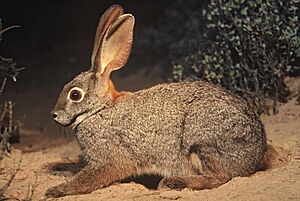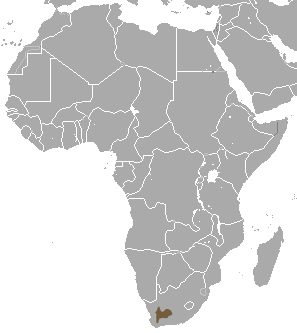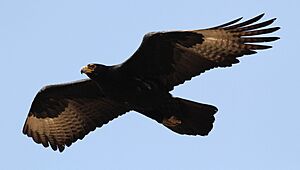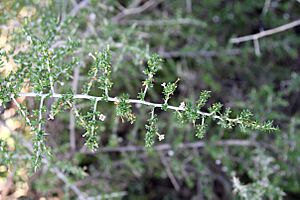Riverine rabbit facts for kids
Quick facts for kids Riverine rabbit |
|
|---|---|
 |
|
| Conservation status | |
| Scientific classification | |
| Genus: |
Bunolagus
|
| Species: |
monticularis
|
 |
|
The riverine rabbit (Bunolagus monticularis) is a very rare rabbit. It is also called the bushman rabbit or bushman hare. You can only find it in the central and southern parts of the Karoo Desert in South Africa. This rabbit is the only member of its group, called Bunolagus, because it has special features that no other rabbits have. It is one of the most endangered mammals in the world. There are only about 500 adult riverine rabbits left, and about 1500 in total.
These rabbits mostly eat plants. However, their usual food sources are disappearing, which makes it hard for them to find enough to eat. This food shortage also causes problems for them to build their homes, called burrows. A unique thing about female riverine rabbits is that they can only have one baby each year. This is a big reason why they are critically endangered, which is the highest danger level for animals. Other special things about them are that they are active at night (nocturnal) and they produce two different kinds of droppings. People are working on plans to help save these rabbits and their homes.
Contents
- What Does the Riverine Rabbit Look Like?
- Riverine Rabbit Family Tree
- Where Do Riverine Rabbits Live?
- Who Hunts the Riverine Rabbit?
- What Do Riverine Rabbits Eat?
- Riverine Rabbit Behavior
- Riverine Rabbit Reproduction and Life Cycle
- How Riverine Rabbits Help Humans
- Why the Riverine Rabbit Is Endangered
- How We Can Help Save the Riverine Rabbit
What Does the Riverine Rabbit Look Like?
The riverine rabbit lives in the Karoo desert in South Africa. It looks a lot like other rabbits, but its ears and body are longer. It usually has a black stripe that goes from the corner of its mouth across its cheek. It also has a white ring around each eye. Its tail is brown and woolly. The fur on its belly and throat is cream or grayish. It has wide, club-like back feet. It has 28 teeth. Its soft fur covers its short, furry legs. Male riverine rabbits weigh about 1.5 kilograms, and females weigh about 1.8 kilograms.
Riverine Rabbit Family Tree
The scientific name for the riverine rabbit is Bunolagus monticularis. Some common names for it are the bushman hare and the bushman rabbit. It also has less common names like boshaas and vleihaas in Afrikaans. These names come from the wet and dense places where they used to live. Genetically, its closest relatives are the Amami rabbit, the Hispid hare, and the European rabbit.
Where Do Riverine Rabbits Live?
Riverine rabbits are found in only a few spots in the Karoo Desert of South Africa's Northern Cape province. One protected area, the Sanbona Wildlife Reserve, has a healthy group of these rabbits. Scientists study and watch them there. As its name suggests, the riverine rabbit likes to live near rivers and in special shrubland. It eats the thick shrubs. The soft soil in these areas helps it dig large burrows and dens. These burrows are used for protection, raising babies, and staying cool or warm.
The riverine rabbit lives in very thick plants along seasonal rivers in the central Karoo region. Its home is a desert or scrub forest. Two common plants it eats are Salsola glabrescens and Lycium species.
These rabbits live specifically in river plants on soft, sandy soils next to rivers that flow only at certain times of the year. Studies show that 67% of this habitat is now broken up. The area where they live is getting smaller. This is a main reason why they are endangered. The biggest reason for this habitat loss is farming with crops and livestock. Over the last 100 years, more than two-thirds of their home has been lost. Today, only about 500 adult riverine rabbits are thought to be living in the wild.
When natural plants along rivers are removed, the rabbits cannot build strong burrows for their babies. This is because the soft topsoil, which they need for digging, is gone. Another problem for their homes is too much grazing by farm animals. This also damages and breaks up the land. Without good homes, fewer rabbits can survive. The remaining habitat is thought to be able to support only about 1,435 rabbits. This shows how little suitable home is left for them.
Who Hunts the Riverine Rabbit?

The riverine rabbit is hunted by birds of prey like falconiformes and black eagles. However, it can jump over bushes that are more than one meter high when a predator chases it. To avoid being caught, it stays active at night. During the day, it rests in a shallow scrape it makes in the soil under a Karoo bush.
What Do Riverine Rabbits Eat?
The riverine rabbit is known for being a "browser." This means it eats leaves, twigs, and bark. They eat plants found along seasonal rivers in the Karoo Desert. This includes plants that like salt, such as the salsola and lycium. Sometimes, they eat grass, especially during the wet season. Besides their regular food, they also eat their own droppings from the daytime. This helps them get vitamins made by bacteria in their gut. It also helps them get minerals like calcium and phosphorus.
Riverine Rabbit Behavior
Riverine rabbits live alone and are active at night. They eat their favorite foods, like flowers, grasses, and leaves, during the night. During the day, they rest in shallow scrapes. They produce two kinds of droppings. At night, when they are active, they make hard droppings. During the day, their droppings are soft and can be swallowed. By eating these soft droppings, the riverine rabbit gets vitamin B and recycles minerals like calcium and phosphorus.
They mate with more than one partner, but they live and find food by themselves. They have their own separate areas where they live. The males' areas overlap a little with the areas of different females. Between August and May, females build a nest in a burrow. They line the nest with grass and fur and block it with soil and twigs. This nest is about 10–15 centimeters wide and 25 centimeters long.
Riverine Rabbit Reproduction and Life Cycle
The riverine rabbit is one of the rarest mammals in the world. We do not know much about how they reproduce, except that males mate with more than one female. They have their babies underground for safety. The female rabbit usually has only one baby. This baby is born helpless, without fur, and blind. It weighs about 40 to 50 grams. It is the only African rabbit that has its babies underground. The helpless baby stays with its mother until it can live on its own.
The low birth rate of only one baby per year is very different from most other rabbits. This is why people are trying to increase the numbers of this endangered species. A group of rabbits is being bred at the De Wildt Cheetah and Wildlife Centre near Pretoria. These rabbits will mate with several individuals. They are the only known rabbit species to make nests for their babies. Very rarely, two babies might be born at once.
How Riverine Rabbits Help Humans
The riverine rabbit helps farmers in many ways. The river plants it eats help hold the soil together. This stops the soil from being washed away during floods. Also, these plants help rainwater soak into the ground, which is good for farmers. Farmers often use windmills to get this groundwater for their animals. So, the riverine rabbit's home indirectly helps humans with farming. This help can continue only if the rabbit keeps eating these plants.
Why the Riverine Rabbit Is Endangered
How Bad Is It?
The riverine rabbit is in extreme danger of disappearing forever. In 1981, it was first called an endangered species. Now, according to the IUCN Red List, it is in the most serious danger category, called critically endangered. This is just one step away from extinction. There are only about 500 adult rabbits left, and about 1500 in total. Both these numbers keep getting smaller. The IUCN Red List predicts that one-tenth of the population will be lost between 2002 and 2022. Another problem is that their very small population is split into about 10 separate groups. Each group has fewer than 50 rabbits.
What Causes the Danger?
The number of rabbits is going down mostly because their home is changing. More than half of their habitat has become unsuitable for them since 1970. This is largely because land is being used for farming. This destroys the special environment the riverine rabbit needs. The area where they can live keeps shrinking. It is predicted that another fifth of their habitat will be lost over the next 100 years. This ongoing destruction is due to raising animals for business in the area.
Another threat is that the isolated groups are separated by fences. These fences are built to keep out animals like jackals, but the rabbits cannot get through them either. Climate change is also damaging the remaining land where they live. Other reasons for fewer rabbits include hunting for fun, food, or collecting. Rabbits also get caught in traps set on farms for other animals. Soil erosion in their habitat also harms them. Animals eating local plants reduce the already small amount of food available for the rabbit. Removing trees and destroying local plants takes away places where rabbits can escape the heat and hide from predators. Finally, structures on rivers, like dams, separate groups of rabbits. This makes it harder for their population to grow faster.
How We Can Help Save the Riverine Rabbit
What Is Being Done Now?
Compared to other similar animals, we do not know much about the riverine rabbit's behavior or what it eats. So, one important effort is to research this species. Scientists are trying to find key information that will lead to better ways to save them. The current plan to protect the remaining rabbits has been criticized. Experts say that a large part of the land that can support the rabbit is not currently protected.
Other efforts include teaching local farmers how to act in ways that help the rabbits. People have also worked to get landowners in the habitat area to agree to certain rules that help the rabbit population. One very important effort has been to carefully watch rabbit populations. This job became harder when a new group of rabbits was found in 2014. The Endangered Wildlife Trust has done a lot of this monitoring.
What Else Can Be Done?
The IUCN suggests more ways to help, showing that current actions are not enough. They recommend catching some rabbits to let them reproduce safely, away from predators or food shortages. They also suggest different ways to manage the habitat and the wild population. Finally, they recommend more efforts to tell local people how to protect the rabbit. The Red List also notes that more research is needed about their lives and what conservation actions would work best.






